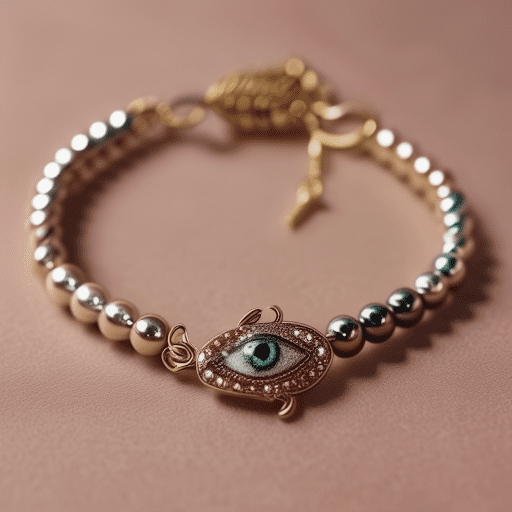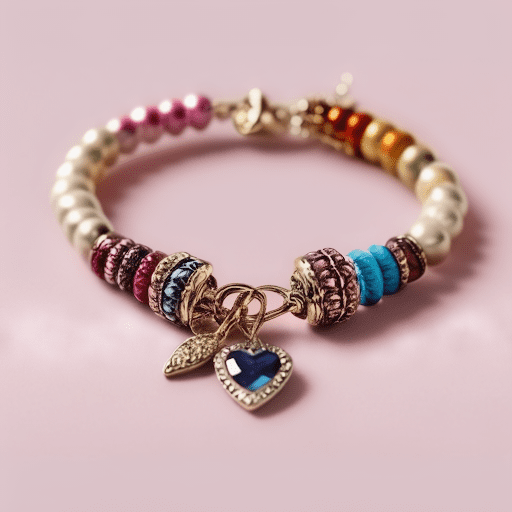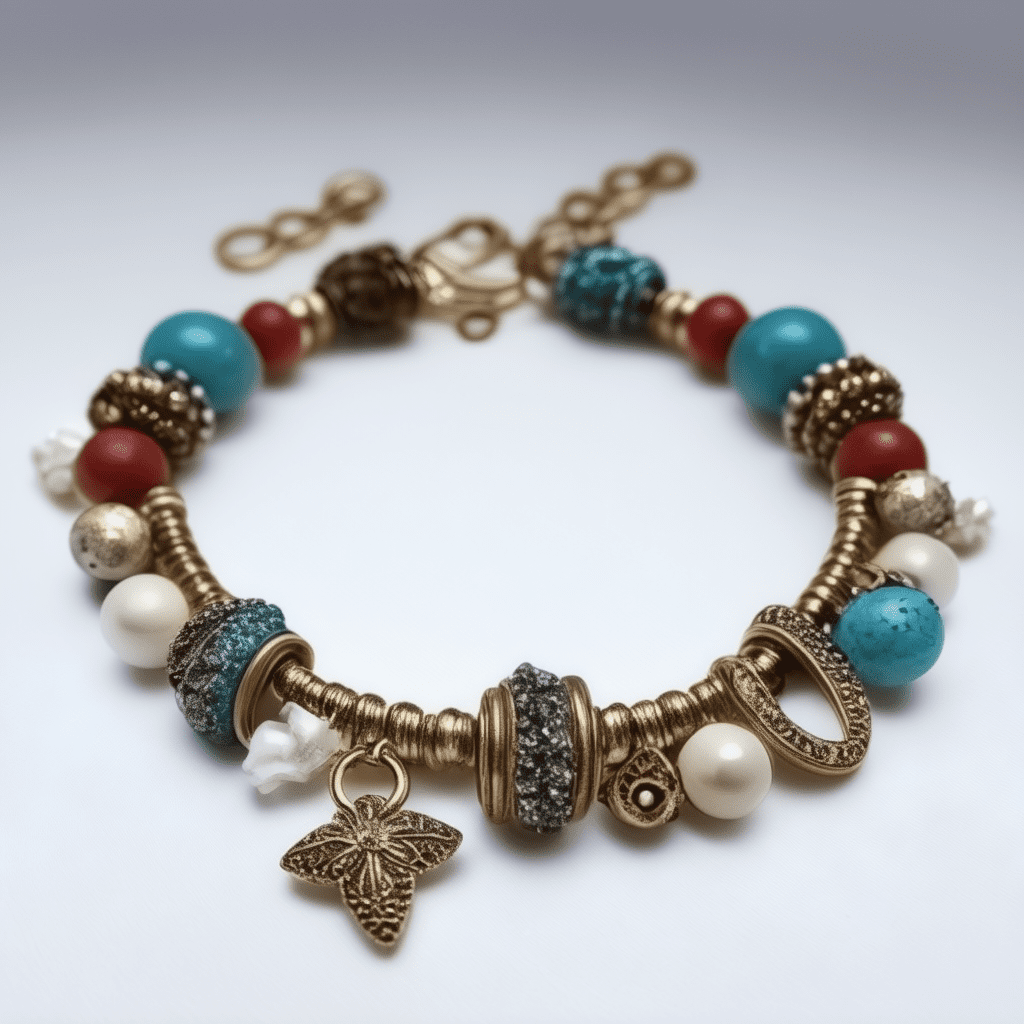“The Fascinating History of Charms and Their Varieties: Exploring Beads, Tools, and Supplies”

Welcome to a captivating journey through the enthralling realms of charm crafting and beadwork. As we embark on this exploration, guided by the expertise of a seasoned beader, we unveil the ancient origins and cultural significance woven into each intricately designed charm. From the dawn of civilization, charms have adorned the lives of humanity, embodying symbols of protection, luck, and spiritual connection. Join us as we delve into the depths of history, tracing the footsteps of ancient civilizations and unraveling the tapestry of diverse traditions that have shaped the enchanting world of charms and beads. Whether you’re a seasoned jewelry maker or a novice enthusiast, prepare to be inspired by the rich cultural histories behind these symbolic treasures.
Charms History: Unearthing Ancient Origins

Believe it or not, these little trinkets hold stories whispered across millennia! We can trace charms way back to prehistoric times, even. Imagine it – people adorning themselves with shells and carved bones over 75,000 years ago! Crazy, right? These early charms weren’t just for looks, though. Folks believed they held magical properties, warding off evil spirits and bringing good luck.
Fast forward to ancient Egypt, and charms became all the rage. Egyptians crafted beautiful amulets from gemstones, rocks, and even wood, believing they’d protect them in the afterlife. Pharaohs were especially fond of them, getting buried with their most prized possessions, charms included! See, charms weren’t just about luck anymore; they were status symbols too.
Explore the vast array of beads and bead varieties used in crafting these ancient charms. From simple seed beads to intricately carved gemstone beads, the options for adornment were as diverse as the cultures that created them. Incorporate different bead varieties into your modern-day charm creations to capture the essence of these ancient traditions and infuse your designs with rich historical significance. Whether you’re crafting a protective amulet or a decorative charm bracelet, the right beads can elevate your piece from ordinary to extraordinary, just like they did for our ancestors millennia ago.
Evolution of Symbolism: Tracing the Roots of Protective Charms
Hold on to your beading needles, folks, because we’re about to dive deep into the fascinating world of charm symbolism! These trinkets haven’t just been jingling around for fun – they’ve carried powerful meanings for centuries. Here’s a glimpse into how their symbolism evolved:
- Prehistoric Times (75,000+ years ago): Imagine our early ancestors crafting charms from shells and carved bones! Worn for protection, these weren’t just decorations – they were believed to ward off evil spirits and bring good luck.
- Ancient Egypt: Egyptians seriously upped the charm game! They crafted beautiful amulets from gemstones, believing they’d grant protection in the afterlife. Pharaohs especially loved them, getting buried with their most prized possessions, charms included! See, these weren’t just about luck anymore; they were status symbols too.
- Ancient Greece and Rome: Victories, gods, and good fortune – that’s what Greek and Roman charms were all about! Soldiers wore charms depicting their deities for courage, while others sported symbols of victory or prosperity. Talk about jingling with pride!
Cross-Cultural Influences: Exploring Global Perspectives on Charm Making
Charms haven’t stayed locked away in one civilization – they’ve traveled the world, picking up new meanings and designs along the way! Let’s jet set around the globe and see how different cultures embraced these little treasures:
- Asia: In China, jade charms represent good health and wealth, while intricate Japanese netsuke depict mythical creatures or scenes. Feng shui anyone?
- Africa: From cowrie shells in West Africa symbolizing fertility to intricately carved masks in Central Africa warding off evil, African charms are as diverse as the continent itself.
- The Americas: Native American cultures used feathers, animal teeth, and stones in their charms, each imbued with specific meanings and spiritual connections. Dreamcatchers, anyone?
Bracelet Trinkets: Crafting Personalized Charms

Alright, enough about history – let’s get our hands on some beads! The beauty of charms is that they’re totally customizable. You can create tiny masterpieces that reflect your personality, hobbies, or even deepest dreams. Here are some ideas to get your creative juices flowing:
- Repurpose with Panache: Don’t toss that broken watch gear or a chipped button – they can become one-of-a-kind charms! Vintage keys, bottle caps, even Scrabble tiles – the possibilities are endless!
- Sculpt from Polymer Clay: Feeling like a mini-Michelangelo? Polymer clay lets you mold tiny figurines, flowers, or symbols – perfect for showcasing your artistic side! Just bake, paint, and attach – easy peasy!
- Embrace Metal Magic: Metal stamping is all the rage! Get yourself a metal blank and some letter stamps, and you can create personalized charms with names, initials, or inspirational words. It’s like having a mini message on your wrist!
Enhance your charm creations with an array of bead pearls, adding a touch of elegance and sophistication to your designs. These lustrous beads, reminiscent of classic pearls, bring a timeless charm to your personalized pieces, elevating them from ordinary to extraordinary. And don’t forget to explore the vast array of bead string varieties to find the perfect foundation for your charms. Whether you prefer sturdy nylon thread, flexible wire, or delicate silk cord, choosing the right string ensures that your charms are not only beautiful but also durable and secure. With a diverse selection of beads and string varieties at your disposal, the possibilities for creating unique and meaningful charms are truly endless.
Artisan Techniques: Mastering the Art of Beadwork and Charm Creation
Alright, history buffs, let’s get crafty! Beadwork is the heart and soul of charm making, and there are a bunch of cool techniques to master. Don’t worry, you don’t need to be a wizard – with a little practice, you’ll be a beading pro in no time!
- Brick Stitch: This versatile technique creates a strong, even foundation for your charms. Imagine tiny bricks forming a flat surface – that’s the magic of brick stitch! Perfect for geometric shapes and intricate designs.
- Peyote Stitch: Feeling circular? The peyote stitch is your go-to for creating round charms or adding a 3D pop to your designs. Think little beaded spheres or even cute little flowers!
- Right Angle Weave (RAW): Up for a challenge? RAW lets you create intricate geometric patterns and even dimensional shapes. It’s like weaving a tiny tapestry with beads – perfect for experienced beaders who want to push their creativity!
Symbolic Meanings: Interpreting the Significance Behind Each Trinket
Charms aren’t just pretty trinkets – they often hold special meanings! Understanding the symbolism behind a charm can make your creations even more personal and powerful. Here’s a quick decoder ring to get you started:
- Hearts: A classic symbol of love and affection. Perfect for a charm bracelet gifted to a loved one.
- Stars: Reach for the stars! Symbols of ambition, hope, and achieving your dreams.
- Animals: Each creature has its own unique meaning. A turtle might represent longevity, while a butterfly signifies transformation. Do your research and pick the animal that resonates with you!
Charm Bracelets and Charms: A Journey Through Time

Bracelets adorned with trinkets – that’s the basic idea, but the story goes way back! Fast forward from those prehistoric shell adornments, and we land in Mesopotamia and Egypt, where folks were rocking charm necklaces and anklets. Imagine that!
Then came the Greeks and Romans, sporting charms depicting their gods or symbols of victory. Victorious much? Skip ahead to the Middle Ages, and knights decorated their belts with charms signifying their status and ancestry. Talk about a jingling family tree!
Finally, the 19th century saw Queen Victoria rocking some seriously decadent charm bracelets. She loved them so much, she even gifted them to friends and family, sparking a major jewelry trend! And that, my friends, is how charm bracelets became the beloved wrist adornments we know and love today. Pretty cool, huh?
Elevate your charm crafting journey with a diverse selection of needle varieties, tailored to your specific projects. From sharp beading needles for delicate seed beads to sturdy needles for stringing larger beads, having the right needle ensures smooth and precise stitching every time. And don’t forget to stock up on essential bead tools supplies like bead design boards, organizers, and storage containers to keep your workspace tidy and your materials easily accessible. With a well-equipped toolkit and an abundance of supplies at your disposal, there’s no limit to the exquisite charm creations you can bring to life.
Historical Significance: Examining the Role of Charms in Different Eras
Charms haven’t just been jingling around for fun – they’ve played a fascinating role throughout history! Let’s take a whirlwind tour and see how these trinkets held meaning across different eras:
- Prehistoric Times (75,000+ years ago): Early humans weren’t just grunting and hunting – they were rocking seashell and carved bone adornments! Believed to ward off evil spirits and bring good luck, these charms were more than prehistoric bling.
- Ancient Egypt: Egyptians seriously upped the charm game! They crafted beautiful amulets from gemstones, believing they’d grant protection in the afterlife. Pharaohs especially loved them – getting buried with their most prized possessions, charms included! See, these weren’t just about luck anymore; they were status symbols too.
- Medieval Times: Forget fidget spinners, knights had charms! Worn on belts, these trinkets displayed family crests, religious symbols, or even lucky charms. Imagine a knight jingling into battle with a tiny horseshoe charm for good luck!
Modern Interpretations: Adapting Ancient Charms for Contemporary Designs
The past is cool, but what about now? The beauty of charms is that they’ve adapted to modern life! We still love the symbolism and personalization, but the designs are as diverse as ever. Here’s a glimpse into how charms have evolved:
- Classic Symbols: Hearts for love, stars for ambition – these timeless symbols are still going strong! You can find them in precious metals, glass, or even wood – the options are endless!
- Pop Culture Craze: From superheroes to video games, pop culture has invaded the charm world! Rep your favorite characters or fandoms with a tiny charm that speaks to your inner geek.
- Personalized Touches: The most meaningful charms are often the most personal. Miniature initials, birthstones, or even tiny photos – the possibilities for customization are endless! Imagine a charm bracelet that tells your unique story.
Tools and Supplies: Equipping Your Beading Journey

Alright, history buffs and future charm maestros, let’s get down to business! You don’t need a dragon’s hoard of supplies to start beading, but a few essentials will make your journey smoother than silk thread. Here’s a quick checklist to get you going:
- Beads! Duh, right? But the variety is mind-boggling! Glass, seed beads, gemstones – the options are endless. Choose colors, shapes, and sizes that tickle your fancy!
- Beading Needle: This isn’t your grandma’s sewing needle – it’s thin and long, perfect for threading those tiny beads. Don’t forget a variety of sizes for different bead types!
- Thread: Strength is key! Look for beading thread specifically designed to handle the weight and friction of your creations. Nylon or silk are popular choices.
- Scissors & Thread Clippers: Snip, snip, hooray! Sharp scissors and thread clippers will keep your thread clean and prevent fraying.
- Pliers: These handy tools come in different shapes and sizes. Round nose pliers help you open and close jump rings, while chain nose pliers can grip wire for bending and shaping.
Ensure your beadwork stays secure with the help of jewelry glue, which provides an extra layer of reinforcement for your creations. Whether you’re attaching findings or securing knots, a dab of jewelry glue can help ensure your beads stay in place for years to come. And don’t forget to explore bead storage solutions to keep your precious materials organized and easily accessible. Whether you opt for stackable containers, compartmentalized trays, or hanging organizers, finding the right storage solution ensures that your beads are ready and waiting for your next burst of creative inspiration.
Essential Equipment: Understanding the Tools Needed for Charm Crafting
Alright, we’ve got the history lesson out of the way, and now it’s time to get your hands dirty – beading time! But before you dive headfirst into that bag of sparkly beads, let’s make sure you have the right tools for the job. These aren’t fancy gadgets – we’re talking essentials that will make your charm-making journey smooth sailing!
- Beading Needles: These aren’t your average sewing needles – think thin and long, like a tiny wizard’s staff for weaving magic with thread! Get a few different sizes, because not all beads are created equal.
- Thread: Strength is key here! Forget flimsy embroidery floss – you want beading thread specifically designed to handle the weight and friction of all those little treasures you’ll be stringing together. Nylon or silk are popular choices, and different thicknesses are good to have on hand.
- Scissors & Thread Clippers: Snip, snip, hooray! Sharp scissors and thread clippers are your best friends for keeping things clean and preventing fraying. No one wants a charm bracelet that looks like a cat went to town on it!
Pliers: Don’t worry, you’re not going into the blacksmithing business – but pliers are super handy for charm making! Round nose pliers are perfect for opening and closing those tiny jump rings that connect everything. Chain nose pliers can grab wire for bending and shaping – think of them as your miniature helping hands.
Quality Materials: Selecting the Finest Beads and Supplies for Your Projects
Now that you’ve got your tool belt ready, let’s talk about the good stuff – the beads themselves! This is where your creativity can really take flight. Here’s a quick rundown of the essentials:
- Bead Variety: The beading world is your oyster – or should I say, “beady” oyster? Glass beads, seed beads, gemstones, even funky polymer clay creations – the options are endless! Choose colors, shapes, and sizes that speak to you and your design ideas.
- Finding Inspiration: Don’t be afraid to hit the craft store aisles or browse online retailers! Bead magazines and websites are also overflowing with inspiration. There’s a whole world of beautiful beads waiting to be discovered!
- Quality Matters: While it’s tempting to grab the cheapest bag of beads, resist the urge! Low-quality beads can be chipped, unevenly colored, or worse – break easily, leaving you frustrated. Invest in decent materials – your creations will thank you for it!
- Clasps & Jump Rings: These little guys are the unsung heroes of the charm world. Clasps keep your bracelet securely fastened, while jump rings connect all your beautiful beads. Make sure they’re the right size and good quality to avoid any bracelet disasters!
References
- [Source: A Brief History Of Charms, Gemporia, gemporia.com]
- [Source: A History of Charms, Monica Rich Kosann, monicarichkosann.com]
- [Source: The History of Amulets and Charms in Ancient Egypt, World History Encyclopedia, worldhistory.org]
- [Source: Ancient Greek and Roman Jewelry, The Metropolitan Museum of Art, metmuseum.org]
- [Source: Repurposed Charm Ideas: Breathe New Life into Old Treasures, The Spruce Crafts, thesprucecrafts.com]
- [Source: How to Make Polymer Clay Charms, wikiHow, wikihow.com]
- [Source: Brick Stitch Basics, Beading Daily, beadingdaily.com]
- [Source: Peyote Stitch for Beginners, Interweave, interweave.com]
- [Source: History of Charms, TheCharmWorks, thecharmworks.com]
- [Source: Beading Supplies 101, The Spruce Crafts, thesprucecrafts.com]
- [Source: Beading Needles: A Beginner’s Guide, Fire Mountain Gems and Beads, firemountaingems.com]

Recent Comments